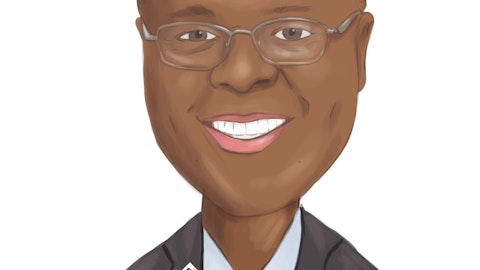Brookline Bancorp, Inc. (NASDAQ:BRKL) Q4 2023 Earnings Call Transcript January 25, 2024
Brookline Bancorp, Inc. isn’t one of the 30 most popular stocks among hedge funds at the end of the third quarter (see the details here).
Operator: Good afternoon, and welcome to Brookline Bancorp Incorporated Fourth Quarter 2023 Earnings Conference Call. All participants will be in listen-only mode. After today’s presentation, there will be an opportunity to ask questions. Please note, this event is being recorded. I would now like to turn the conference over to Brookline Bancorp’s Attorney, Laura Vaughn. Please go ahead.
Laura Vaughn: Thank you, Emily, and good afternoon, everyone. Yesterday, we issued our earnings release and presentation, which is available on the Investor Relations page of our website, brooklinebancorp.com and has been filed with the SEC. This afternoon’s call will be hosted by Paul A. Perrault and Carl M. Carlson. This call may contain forward-looking statements with respect to the financial condition, results of operations and business of Brookline Bancorp. Please refer to Page 2 of our earnings presentation for our forward-looking statement disclaimer. Also, please refer to our other filings with the Securities and Exchange Commission, which contain risk factors that could cause actual results to differ materially from these forward-looking statements.
Any references made during this presentation to non-GAAP measures are only made to assist you in understanding Brookline Bancorp’s results and performance trends and should not be relied on as financial measures, of actual results or future predictions. For a comparison and reconciliation to GAAP earnings, please see our earnings release. I’m pleased to introduce Brookline Bancorp’s Chairman and CEO, Paul Perrault.
Paul Perrault: Thanks, Laura, and good afternoon, all. Thank you for joining us for today’s earnings call. 2023 was a challenging year for the banking industry. We had a very productive one for Brookline Bancorp. We started the year with the successful acquisition, management transition and integration of PCSB Bank. Mid-February, the systems conversions were completed without incident and the synergies identified were realized. Then in March and April, as several banks failed, we were able to assist impacted customers in our markets as they navigated the significant near-term uncertainty it created. In a volatile interest rate environment, we have added bankers to our teams, while continuing to expand and enhance our technology infrastructure as well as our product and service offerings across our three banks with a sharp focus on boutique commercial banking.

Geographically, we are excited about the opportunities PCSB Bank provides us in the Hudson Valley of New York. In Massachusetts, Brookline Bank expanded our Wakefield lending office and opened a new lending office in Needham. And in Rhode Island, Bank Rhode Island has opened new branches in both Cranston and Newport. Eastern Funding, our National Equipment Finance unit specializing in laundromats, tow trucks and fitness equipment continue to demonstrate solid growth with enviable industry credit performance, which we attribute to the team’s narrow focus and very deep expertise. I will now turn it over to Carl, who will review the company’s fourth quarter results.
Carl Carlson: Thank you, Paul. Yesterday, we reported net income for the quarter of $22.9 million or $0.26 per share. Total assets finished the year at $11.4 billion, approximately $200 million higher than Q3, driven by loan growth of $261 million, offset by a decline in other assets. We experienced strong loan growth in all categories with commercial growth of $118 million, commercial real estate of $95 million, equipment finance $41 million and $7 million in consumer loans. In the fourth quarter, we originated $792 million in loans at a weighted average coupon of 727 basis points. The weighted average coupon on the core loan portfolio rose 10 basis points to 592 basis points at December 31st. On a linked quarter basis, the yield on the loan portfolio increased 17 basis points to 6.01%.
On the funding side, consumer — customer deposits were basically flat, while broker deposits declined $13 million and borrowings increased $242 million. Deposit growth continued to be focused on higher rate savings and time deposits, offset by declines in DDA and Money Market products. Total funding cost increased 23 basis points in the quarter to 339 basis points. Total average interest-earning assets grew $63 million on a linked quarter basis, and the net interest margin declined three basis points to 3.15%, resulting in net interest income of $83.7 million, a decline of $500,000 from the third quarter. Non-interest income was $8 million, which was $2.5 million higher than the prior quarter, driven by loan level, derivative income, gains on participated loans and higher other non-interest income.
Expenses were $59.2 million for the quarter, up $1.5 million from Q3, primarily driven by compensation and benefits. Provision for credit losses was $3.8 million for the quarter, up $800,000 from Q3. Yesterday, the Board approved maintaining our quarterly dividend of $0.135 per share to be paid on February 23rd to stockholders of record on February 9th. On an annualized basis, our dividend payout approximates a yield of approximately 5%. This concludes my formal comments. And I’ll turn it back to Paul.
Paul Perrault: Thank you, Carl. And we will now open it up for questions.
See also 15 Highest Quality Boot Brands in the US and 19 Best Reusable Water Bottles on Amazon Under $50.
Q&A Session
Follow Brookline Bancorp Inc (NASDAQ:BRKL)
Follow Brookline Bancorp Inc (NASDAQ:BRKL)
Receive real-time insider trading and news alerts
Operator: Thank you. [Operator Instructions] Our first question for today comes from Mark Fitzgibbon of Piper Sandler. Your line is now open. Please go ahead, Mark.
Mark Fitzgibbon: Hey, guys. Nice quarter.
Paul Perrault: Thank you.
Carl Carlson: Thanks.
Mark Fitzgibbon: First question I had for you — the first question I had was loan growth continues to outpace deposit growth. And I know you’re opening some new branches and hopefully, overtime, that will catch-up. But I guess I was curious with the loan-to-deposit ratio at 113%. Where would you be willing to let that go to, as you work hard to bring in new deposits?
Paul Perrault: Back in the old days, when you started looking at us, we were quite a bit higher than this, and I don’t think I’d want to go back to that level, which was like 175. But we’re working hard at generating core deposits. The issue really has been that loan generation has been quite strong. So we’ll keep with that strategy. And we’ll see how we can manage the loan-to-deposit ratio, but I would hate to put a hard number out there, Mark.
Mark Fitzgibbon: And then Carl…
Paul Perrault: We know lower is better.
Mark Fitzgibbon: Okay. And then Carl, on the margin, it feels like almost every bank is predicting that their margin will decline a little bit more in the first half of this year, and then start to rebound when the Fed begins to hopefully ease. Do you share that view, for Brookline?
Carl Carlson: Our core projections for the first quarter are probably flat to down a couple more basis points. A lot of our growth in the loan book came near the end of the quarter. So you didn’t really see it in the average balances sort of the ending balances. And of course, that’s been funded for the most part right now with as wholesale borrowings, so the wholesale borrowings jumped up $242 million. So that’s definitely at a lower spread than our going margin. As Paul mentioned, we’re working hard to try to get those deposits up to improve the margin. So while we might have net interest income up, the margin may be down a little bit. But as we look forward, depending on what the Fed does with rates, what the market does, we do expect the margin to improve going out through 2024.
Mark Fitzgibbon: Okay. And then Carl, can you help us think about expense growth given the new branches and people that you’re hiring, how that’s likely to affect operating expenses in 2024?
Carl Carlson: So if you use our fourth quarter run rate, it’s a little over $59 million. I think we’ll always grow maybe 1% or 2% off that run rate, it will pop a little bit in Q1 because of seasonality factors associated with payroll taxes and incentive accruals for the most part, unless we start getting snow storms, but so far, we’ve been right there. And so that’s kind of what we usually see in the first quarter.
Paul Perrault: And the number of branches that we’re going to open is very strategic and limited because there will be some closures and some moving of things.
Carl Carlson: I’ll tell them about the closures Paul.
Paul Perrault: We’re not going to change the expense to move very much, yeah.
Mark Fitzgibbon: Okay. And then in your slide deck on Page 18, you have kind of a breakdown of the office portfolio and the maturities. I guess I was curious, if you could share with us any sort of high-level thoughts on what sort of the occupancy rates look like on those office buildings today?
Carl Carlson: I don’t have occupancy rates at my fingertips on these loans. I know our guys are looking at that all the time. But we continue to work with our borrowers, anybody that’s coming up for maturities on refinancing their loans. Paul, you have any more time?
Mark Fitzgibbon: Okay. Thank you.
Paul Perrault: No, I would think a lot of it is pretty good because it’s mostly outside of the core business. It’s all over the Hudson Valley. It’s all over Rhode Island and a lot of it has been suburban Boston, which haven’t really seen the occupancy issues that central businesses district has.
Mark Fitzgibbon: Thank you
Operator: Our next question comes from Nick Cucharale with Hovde Group. Please go ahead.
Nick Cucharale: Good afternoon, everyone. How are you?
Paul Perrault: Hi, Nick.
Carl Carlson: Very good.
Nick Cucharale: So I just wanted to follow-up on the accelerating loan growth. Could you provide some color there? Was it simply capitalizing on some good opportunities this quarter, and that pace should revert back towards the mid single-digits we’re used to seeing from you guys?
Carl Carlson: I think we’re focused on probably growth of 4% to 5% for 2024. We closed — certainly closed more loans in Q4 than I was expecting. And so some of that growth probably in Q1 has gotten pulled into Q4. So we’re starting the year off very strong. And of course, that’s my guys that we stand back on the budgeting side, but that’s another story. But we’re off to a good start for 2024. And I think some of the pipelines are going to have to rebuild, so Q1 maybe a little slower side. But we’re projecting 4% to 5% growth for 2024 at this point.
Nick Cucharale: I appreciate that color. In a related vein, can you give us some color on the lending environment across your markets? Have you seen a pullback or any hesitance from your competition given the funding and capital challenges?




